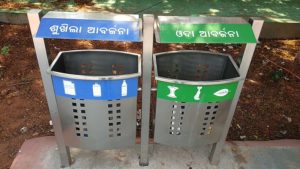Bhubaneswar city has been continuously populated for thousands of years, and is considered India’s ‘City of Temples’ for the over 500 temples in the region, a reminder of its ancient history. Now the city is in need of a breath of fresh air, with transport emissions, household air pollution and industries like brick kilns accounting for declining air quality in the city in recent years.
At a BreatheLife training with WHO Country Office for India and Clean Air Asia, in partnership with Bhubaneshwar Municipal Corporation (BMC), held on 12th December, 2019, stakeholders in the city focused on health impacts of air pollution, air quality monitoring and standards.
Following the training programme, Bhubaneshwar Municipal Corporation officially committed to join BreatheLife, working to meet WHO air quality guidelines and interim targets. The event was joined by Municipal Commissioner, WHO representative, Clean Air Asia team, officials from Bhubaneshwar Development Authority, Bhubaneshwar Municipal Corporation and Bhubaneshwar Smart City Ltd and other relevant stakeholders.

Sri Prem Chandra Chaudhary, Municipal Commissioner of Bhubaneshwar Municipal Corporation stressed that public engagement should be major aspect of the BreatheLife campaign. He also highlighted the need for an immediate action plan to reduce the air pollution in the next 3-4 years.
The 2018 Comprehensive Action Plan for Clean Air is aimed at addressing air pollution in six cities in Odisha State. It outlines challenges in addressing air pollution and lays out baseline actions in key sectors.
A city with a population of 838,000, Bhubaneshwar is focusing on increasing active mobility like walking and cycling, and improving public transit networks under the Smart City plan.
Bhubneshwar Municipal Corporation has set up a solid waste initiative, including community engagement and door-to-door collection of segregated waste for wet and dry waste, periodic road sweeping to reduce dust and installation of Waste to Energy plant in Bhubaneshwar. The City has also placed strict measures on open burning in order to reduce air pollution from burning of agricultural and solid waste.
The city has also launched campaigns to replace kerosene lamps with solar lighting, and is addressing household air pollution by linking with national government programs to transition to clean technology and energy for cooking.

National Professional Officer (Environment and Public Health) of WHO India, Manjeet Singh Saluja, congratulated the leadership of Bhubaneshwar city for committing to BreatheLife as a truly a visionary step for ensuring clean air for the city.
Clean Air Asia’s India Director Prarthana Borah said that CAA India is excited to have Bhubaneshwar commit to Breathe Life. Bhubaneshwar has been very proactive towards addressing environmental concerns and committing to Breathe Life adds another feather to the cap since the focus on health impact of air pollution will increase public engagement.
Hero photo © Chinu18593 via Wikicommons; Waste bins © Soumendra Kumar Sahoo Wikicommons; Temple © Bikashrd via Wikicommons